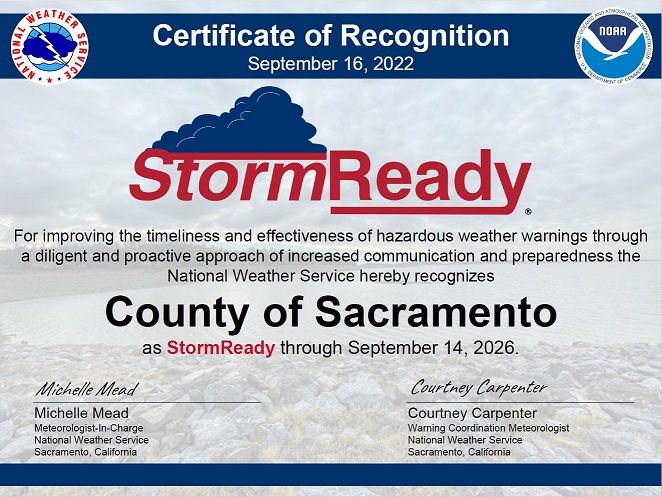Storms in the Sacramento Valley can cause localized damage, and rising water levels in rivers and streams can result in flooding. Use the following information to find out what you can do to prepare and protect yourself, your family, and your property during storms and floods.
So, You Live Behind a Levee!
Most people know that levees are built near rivers and lakes to reduce flooding risk, but what does it mean to live behind one? Are your home and loved ones safe from floods? How much protection does the levee really provide? What do you need to know to be safe? Get more information, view the
So, You Live Behind a Levee! brochure.
Prepare your Home
- Elevate the furnace, water heater, and electric panel in your home if you live in an area that has a high flood risk.
- Consider installing "check valves" to prevent flood water from backing up into the drains of your home.
- If feasible, construct barriers to stop floodwater from entering the building and seal walls in basements with waterproofing compounds.
- Property insurance does not typically cover flood damage.
- Talk to your insurance provider about your policy and consider if you need additional coverage.
- Prepare a portable kit of emergency supplies in case you have to evacuate.
- Familiarize yourself with the terms that are used to identify a thunderstorm hazard, including understanding the difference between a severe thunderstorm watch and a severe thunderstorm warning.
- A
flood watch or
flash flood watch means there is a possibility of flooding or a flash flood in your area.
- Be prepared to evacuate.
- If time allows, bring in outside furniture and move your valuables to higher places in your home.
- Unplug electrical appliances, moving them to higher levels, if possible. However, do not touch an electric appliance if you are wet or standing in water. If you have a car, fill the gas tank in case you have to evacuate.
- A
flood warning means a flood is occurring or will likely occur soon. If you are advised to evacuate do so immediately.
- A
flash flood warning means a flash flood is occurring. Seek higher ground immediately; do not wait for instructions.
-
Resources
Plan to Evacuate
- Plan how you will leave and where you will go if you are advised to evacuate.
- If you do not have a car, plan alternate means of evacuating.
- Plan places where your family will meet, both within and outside of your immediate neighborhood. Identify several places you could go in an emergency, a friend's home in another town, a motel or public shelter.
- If you have a car, keep a half tank of gas in it at all times in case you need to evacuate.
- Become familiar with alternate routes and other means of transportation out of your area.
- Take your
emergency supply kit.
- Lock the door behind you. Listen to
NOAA Weather Radio for information.
- Take your pets with you, but understand that only service animals may be permitted in public shelters.
- Plan how you will
care for your pets in an emergency.
- If time allows:
- Call or e-mail the "out-of-state" contact in your family communications plan.
- Tell them where you are going.
- Leave a note telling others when you left and where you are going.
- Check with neighbors who may need a ride.
- Do not walk through moving water, if possible.
- Look for areas where the water is not moving.
- What might seem like a small amount of moving water can easily knock you down.
- Do not drive into flooded areas.
- If your vehicle becomes surrounded by rising water, get out quickly and move to higher ground, if possible.
Stay Informed
- Local authorities may not immediately be able to provide information on what is happening and what you should do. However, you should listen to NOAA Weather Radio, watch TV, listen to the radio or check the Internet often for official news and instructions as they become available.
- If it has been raining hard for several hours or if it has been raining steadily for days there may be the potential for flooding. Use common sense and available information. If water is rising quickly or you see a moving wall of mud or debris, immediately move to higher ground.
- Stay out of flood waters, if possible. The water may be contaminated or electrically charged. However, should you find yourself trapped in your vehicle in rising water get out immediately and seek higher ground.
- Stay away from downed power lines to avoid the risk of electric shock or electrocution.
- Do not return to your home until local authorities say it is safe. Even after flood waters recede, roads may be weakened and could collapse. Buildings may be unstable, and drinking water may be contaminated. Use common sense and exercise caution.
Resources
Additional Information
For additional detailed storm and flood related information and resources please visit
StormReady.org

